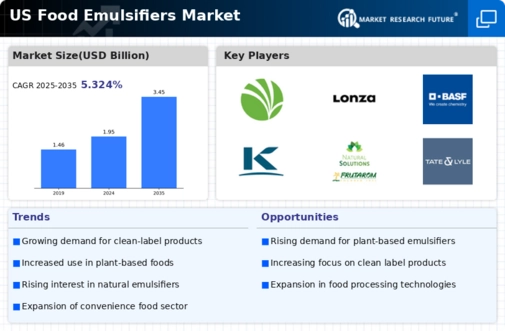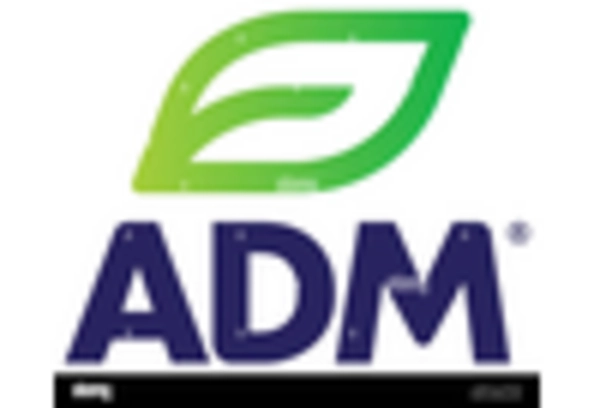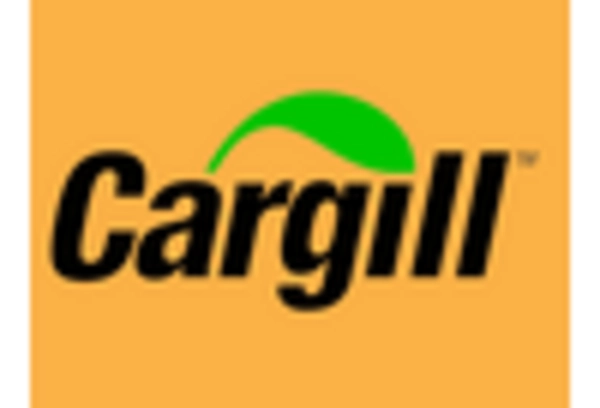Health and Wellness Trends
The food emulsifiers market is significantly influenced by the growing health and wellness trends among consumers in the US. As individuals become more health-conscious, there is a rising demand for products that are perceived as healthier alternatives. This trend has led to an increased interest in natural and organic emulsifiers, which are often viewed as more beneficial compared to synthetic options. Market data indicates that the organic food sector is expected to grow by over 10% annually, further driving the need for emulsifiers that align with these health trends. Manufacturers are responding by reformulating products to include emulsifiers that cater to health-conscious consumers, thus enhancing the overall growth of the food emulsifiers market.
Rising Demand for Processed Foods
The food emulsifiers market is experiencing a notable surge in demand due to the increasing consumption of processed foods in the US. As consumers seek convenience, the market for ready-to-eat meals, snacks, and baked goods expands. According to recent data, the processed food sector is projected to grow at a CAGR of approximately 4.5% over the next five years. This growth is likely to drive the need for emulsifiers, which enhance texture, stability, and shelf life. Food emulsifiers play a crucial role in improving the sensory attributes of these products, making them more appealing to consumers. Consequently, manufacturers are increasingly incorporating emulsifiers into their formulations to meet consumer preferences, thereby propelling the food emulsifiers market forward.
Innovation in Food Processing Techniques
The food emulsifiers market is benefiting from ongoing innovations in food processing techniques. Advances in technology are enabling manufacturers to develop new emulsifiers that improve product quality and functionality. For instance, the introduction of high-performance emulsifiers allows for better emulsification and stabilization in various food products. This innovation is particularly relevant in the dairy and bakery sectors, where texture and consistency are paramount. As the food industry continues to evolve, the demand for innovative emulsifiers is likely to increase, thereby fostering growth in the food emulsifiers market. Furthermore, the integration of automation and smart technologies in food processing is expected to enhance efficiency, further driving the market.
Consumer Preference for Clean Label Products
The food emulsifiers market is increasingly shaped by consumer preference for clean label products. As transparency in food labeling becomes more critical, consumers are actively seeking products with fewer artificial ingredients. This shift has prompted manufacturers to reformulate their offerings, opting for emulsifiers derived from natural sources. Data suggests that the clean label trend is expected to influence over 30% of new product launches in the coming years. Consequently, the food emulsifiers market is likely to see a rise in demand for natural emulsifiers that meet these consumer expectations. This trend not only enhances product appeal but also aligns with the broader movement towards healthier eating habits.
Regulatory Compliance and Food Safety Standards
The food emulsifiers market is significantly impacted by the evolving regulatory landscape and food safety standards in the US. As regulatory bodies impose stricter guidelines on food additives, manufacturers are compelled to ensure compliance with these regulations. This has led to an increased focus on the safety and efficacy of emulsifiers used in food products. Market analysis indicates that adherence to these standards is crucial for maintaining consumer trust and brand reputation. As a result, companies are investing in research and development to create emulsifiers that not only meet regulatory requirements but also enhance product quality. This emphasis on compliance is likely to drive growth in the food emulsifiers market as manufacturers strive to align with safety standards.

















Leave a Comment